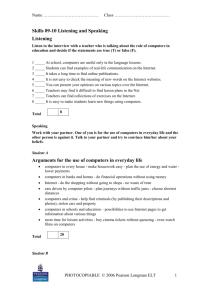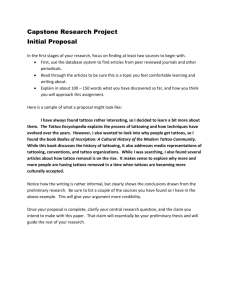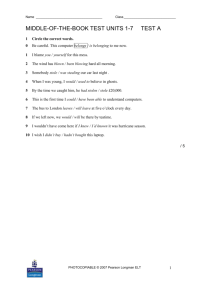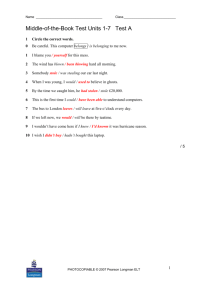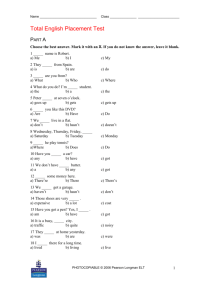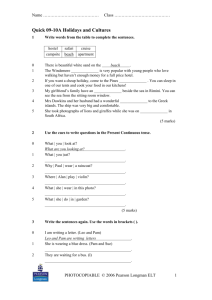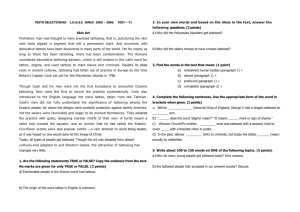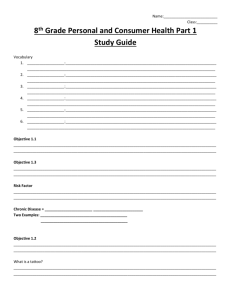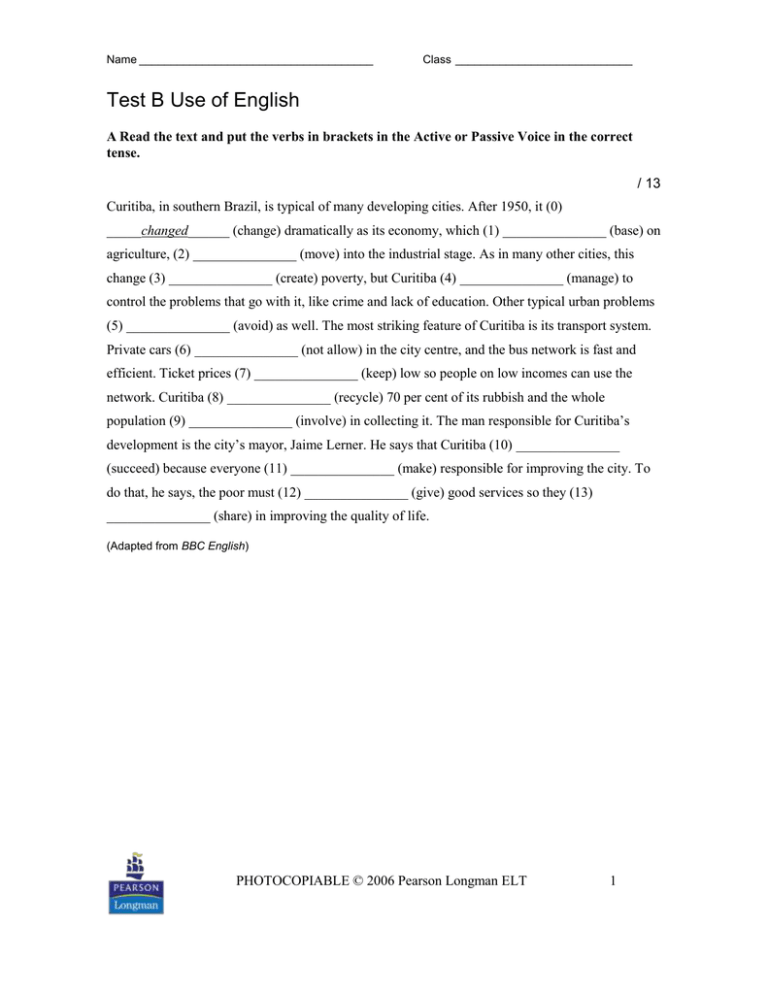
Name _____________________________________
Class ____________________________
Test B Use of English
A Read the text and put the verbs in brackets in the Active or Passive Voice in the correct
tense.
/ 13
Curitiba, in southern Brazil, is typical of many developing cities. After 1950, it (0)
_____changed______ (change) dramatically as its economy, which (1) _______________ (base) on
agriculture, (2) _______________ (move) into the industrial stage. As in many other cities, this
change (3) _______________ (create) poverty, but Curitiba (4) _______________ (manage) to
control the problems that go with it, like crime and lack of education. Other typical urban problems
(5) _______________ (avoid) as well. The most striking feature of Curitiba is its transport system.
Private cars (6) _______________ (not allow) in the city centre, and the bus network is fast and
efficient. Ticket prices (7) _______________ (keep) low so people on low incomes can use the
network. Curitiba (8) _______________ (recycle) 70 per cent of its rubbish and the whole
population (9) _______________ (involve) in collecting it. The man responsible for Curitiba’s
development is the city’s mayor, Jaime Lerner. He says that Curitiba (10) _______________
(succeed) because everyone (11) _______________ (make) responsible for improving the city. To
do that, he says, the poor must (12) _______________ (give) good services so they (13)
_______________ (share) in improving the quality of life.
(Adapted from BBC English)
PHOTOCOPIABLE © 2006 Pearson Longman ELT
1
B There are mistakes in seven out of these ten sentences. Rewrite them correctly.
/ 10
0 My boyfriend, which father is a scientist wants to study mathematics.
My boyfriend, whose father is a scientist,________________
wants to study mathematics.___________________________
00 He made a few suggestions about how we could spend the money.
correct____________________________________________
__________________________________________________
1 Roosevelt that became famous for his military achievements was the 26th president of the US.
__________________________________________________
__________________________________________________
2 I’d like John to come to our party. He tells so funny jokes.
__________________________________________________
__________________________________________________
3 Our biology teacher made a great influence on Tom’s future career.
__________________________________________________
__________________________________________________
4 Many pupils use their mobile phones at school, what is considered unacceptable.
__________________________________________________
__________________________________________________
5 Richard used to be crazy about British rock groups such as The Rolling Stones.
__________________________________________________
__________________________________________________
PHOTOCOPIABLE © 2006 Pearson Longman ELT
2
6 I read an article who discussed the issue of euthanasia in some depth.
__________________________________________________
__________________________________________________
7 He was such unpredictable that Ann decided to break off her engagement.
__________________________________________________
__________________________________________________
8 I got fed up with being criticised by people from other advertising agencies.
__________________________________________________
__________________________________________________
9 There are a lot of teenagers who have a good command of a foreign language.
__________________________________________________
__________________________________________________
10 Fresh evidence suggests that the woman may be forced to commit suicide.
__________________________________________________
__________________________________________________
PHOTOCOPIABLE © 2006 Pearson Longman ELT
3
C Complete the idioms with one appropriate word. Then explain in English the meaning of
each idiom.
/9
0
She was as sick as a ________dog_____________________ .
She was very ill.____________________________________
1
It’s a pity he let the cat out of the ______________________ .
_________________________________________________
2
Margaret has always been the black ____________________ .
of the family. ______________________________________
3
I’m not going to join the rat ___________________________ .
_________________________________________________
4
She has a bee in her _____________________ about dancing.
_________________________________________________
5
My Scottish niece, who only speaks English, feels like a fish out of __________ when she goes
abroad.
__________________________________________________
6
I wish I could be a fly on the ___________________________ during their meeting.
__________________________________________________
PHOTOCOPIABLE © 2006 Pearson Longman ELT
4
D Complete the text with appropriate words. Use only one word in each gap.
/3
Being a boss in a busy transport firm, I am used to making (0) __it_ in business, even if it means
difficult discussions with my employees. Yet some of these contacts can be rather unpredictable and
surprising. For example, last week an employee of mine asked for a pay rise. Although she came (1)
_____ as a very intelligent person, I had to (2) _____ down her request because she hadn’t been
with the firm long enough. As a rule, I don’t (3) _____ in for talking with people in such situations
for long, so she left immediately. By the way, she didn’t appear terribly disappointed. Still, imagine
my surprise when next morning she turned (4) _____ an hour early for our regular staff meeting and
asked to see me. She entered my office carrying a parcel wrapped (5) _____ in coloured paper. She
was all smiles and said, ‘Please accept this thank you gift. Thanks to you, I know now what I really
want to do in my life, and I’m sure I’ll (6) _____ to the top one day!’ Inside, there was a book of her
poems.
E Complete the sentences with the correct word.
/5
0
Mr Smith made/got angry the very moment he saw her.
1
My mother voiced her objection to my plan to pierce/varnish my ears.
2
Since they were striding/strolling across the lawn, I was soon left behind.
3
The catchy/sinister plot of the film made everybody scared.
4
I tried taking sleeping pills but they didn’t make/have any effect.
5
They didn’t buy anything there because the shop sold tacky/trendy souvenirs.
6
We stopped on the way to admire the very picturesque/attractive countryside.
7
When Barbara was pregnant, she went off/ turned off sweets and sugar.
8
An enraged/indolent customer made a complaint to the manager.
9
Why are you yawning/shrieking? Are you bored with what I’m saying?
10 Your hairstyle is a bit tasteless/dated. It was fashionable many years ago.
TOTAL
PHOTOCOPIABLE © 2006 Pearson Longman ELT
/ 40
5
Test B Writing
TASK
Look at the drawing and speculate about the kind of person who could live in this place. Write
a description four paragraphs long about the person and the room. Include the following
information:
the room itself (furniture, arrangement and decoration);
the person’s age;
the person’s likes and dislikes and how they are reflected in the choice of objects in the room;
the person’s character and how it is reflected in the room arrangement;
the person’s moods and ways of spending money in the room.
The description should be 200–250 words. Do not exceed the word limit.
In your description, include:
expressions: very, a bit (too), quite, rather, absolutely, much, slightly, fairly, pretty, extremely,
totally, completely, really;
examples of relative clauses;
structures with so and such.
TOTAL
PHOTOCOPIABLE © 2006 Pearson Longman ELT
/ 20
6
Test B Reading
Welcome to SKIN DEEP – The art of the tattoo
While its meaning has varied from people to people and from place to place, tattooing has most
often served as a sign of social status, as a mark of one’s passage through life, or simply as a way to
beautify the body. Tattooing had existed for thousands of years before England’s Captain Cook
found it in the South Pacific in 1769, but it was his crew and other merchant and naval seamen like
him who soon spread the art to Europe and America.
[1] The close relationship between naval men and tattooing developed quickly after Cook’s
voyages to the South Pacific. At first, sailors’ tattoos were drawn by native tattooists; then sailors
began to tattoo each other aboard ship. Eventually, professional tattoo shops, many of them
established by former sailors, appeared in port cities around the world. The practice became so
entrenched among seamen that it is estimated that by the end of the nineteenth century, 90 per cent
of all sailors in the United States Navy had tattoos.
[2] By the second half of the nineteenth century, tattoos were still largely viewed as
shocking and frightful, the mark of a person exiled from society. Popular magazines of the time
printed articles such as ‘The Savage Origin of Tattooing’ that linked tattooing with cannibals,
criminals and lunatics. However, by the dawn of the twentieth century, a number of circumstances
had arisen that together helped prompt the spread of tattooing. An electric tattooing machine
patented in 1891 allowed for easier, faster, and more decorative tattooing. In Europe and America,
fascination with the new and unusual grew as restrictive Victorian social norms fell away. It was in
this environment that tattoo artists set up shops and made the art of tattooing available to the brave,
the curious and the impulsive.
[3] Prejudice often influenced sailors’ choice of tattoo design. Roosters were thought to
protect sailors from drowning. The Christian cross tattooed on the feet was thought to guard against
shark attack. Yet another superstitious custom held that sailors should be tattooed with the image of
a dragon when they crossed the international date line. While tattoo imagery was often superstitious
in nature, getting tattooed was also a highly practical decision: it increased the chance of a body
being identified if lost overboard.
PHOTOCOPIABLE © 2006 Pearson Longman ELT
7
[4] Just as sailors brought the tattoo to America from exotic ports of call, the circus and side
show took the tattoo across the country. Circus and side show performers often wore tattoos as a
way of increasing their appeal to audiences and thus improving their earnings. As early as 1884,
carnivals, side shows, circuses and travelling fairs were advertising tattooed performers among their
acts. During the Depression, some tattoo artists who were unable to support themselves, travelled
with circuses and side shows. As the American public lost interest in the carnival side show, many
tattoo celebrities joined larger circuses or opened their own tattoo parlours.
[5] During the American Civil War, patriotic themes became very popular. Tattoos
commemorating the battle between the Monitor and the Virginia (formerly the Merrimack) and the
Alabama and the Kearsarge began appearing on sailors’ chests and backs. Flags and eagles became
popular symbols. Tattoos also reflected the navy’s transition from sail to steam.
Once regarded in the West as frightening and unpleasant, the tattoo has enjoyed great
popularity in our own culture in recent years. Everywhere we look today – movies, advertisements,
television – there are signs that people of all walks of life appreciate and practise the art of the
tattoo.
PHOTOCOPIABLE © 2006 Pearson Longman ELT
8
TASK 1
Read the article and match the paragraphs (1–5) with the headings (A–E).
/5
A The Tattoo in the Circus and Side Show.
B Tattoo: the Mark of the Sailor
C Patriotic Symbols
D The Spread of Tattooing
E
The Role of Superstition
TASK 2
Read the article again and answer the questions.
/5
1
Who were the first people to draw sailors’ tattoos?
2
What happened in 1891?
3
What tattoo was supposed to protect sailors against the attack of sharks?
4
Why did circus and side-show performers wear tattoos?
5
What were the most popular tattoos during the Civil War?
TOTAL
PHOTOCOPIABLE © 2006 Pearson Longman ELT
/ 10
9
Test B Listening
TASK
Track 5
Listen to two people giving their opinions about a film they have seen recently. Match each
opinion (1–10) with the person who said it. Some opinions were expressed by both people.
Tick (✓) your answers in the table below.
/ 10
Woman
1
The film has a great story based on a fairy tale I love.
2
The plot and characters are not surprising enough.
3
The film would be better if it could be made shorter.
4
The sound track would appeal to a teenage audience.
5
The music was too contemporary.
6
The film is addressed to a female viewer.
7
Julie Andrews’ and Anne Hathaway’s acting is one of the
film’s strengths.
8
The film shows an ideal imaginary country.
9
The film could do with a few bad characters.
10
The film’s drawbacks are compensated for by the fact that it
is a comedy.
Man
Both
TOTAL
PHOTOCOPIABLE © 2006 Pearson Longman ELT
/ 10
10
Test B Speaking
Debate Task
‘Beauty is in the eye of the beholder.’
You will have a conversation with your examiner. Discuss the aspects of beauty which make it
subjective and those which you think are more objective. Your examiner will sometimes
contradict you. Try to react to your examiner’s counter-arguments. You have 30 seconds to
think over your points.
Here are some arguments you may wish to include:
For
Against
Appreciation of beauty is a matter of individual
taste.
There are classical definitions of beauty which
might be seen in someone’s face or the
symmetry of a building.
It isn’t possible to force someone else to see
beauty in something.
Some things are just plain ugly.
A person creates an individual concept of beauty
through his/her own experiences.
Today what is beautiful is too influenced by
changing fashions and political correctness.
Opinions about what is beautiful are often
instinctive and intuitive and not always easy to
express.
What is considered beautiful today should still
be thought beautiful in 100 years’ time.
TOTAL
PHOTOCOPIABLE © 2006 Pearson Longman ELT
/ 20
11

